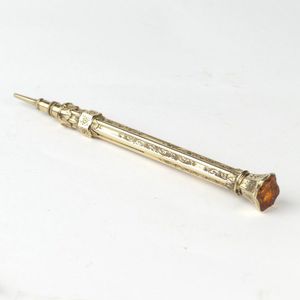Victorian Rose Gold Propelling Pencil with Foliate Designs
A Victorian 9 carat rose gold propelling pencil, later 19th century, with maker's mark E.B. The hexagonal shaped pencil with chased foliate designs and a turban shaped finial with a stone seal; hallmarked 9C to shaft. Length 12.5 cm
You must be a subscriber, and be logged in to view price and dealer details.
Subscribe Now to view actual auction price for this item
When you subscribe, you have the option of setting the currency in which to display prices to $Au, $US, $NZ or Stg.
This item has been sold, and the description, image and price are for reference purposes only.
- Finial - An architectural decoration, found on the upper parts of of an object. On furniture they are usually found on pediments, canopies and shelf supports. On smaller ceramic or silver items, such as spoons, they may decorate the top of the item itself, or the lid or cover where they provide a useful handle for removal.
Finials have a variety of shapes and forms. They may be urn-shaped, baluster shaped round or spiral, but usually taper into an upper point. Many real life shapes may also be used as finials, such as pineapples, berries, pinecones, buds, lotus and acorns. Sometimes animals such as a lion are depicted, or fish and dolphins. - Victorian Period - The Victorian period of furniture and decorative arts design covers the reign of Queen Victoria from 1837 to 1901. There was not one dominant style of furniture in the Victorian period. Designers used and modified many historical styles such as Gothic, Tudor, Elizabethan, English Rococo, Neoclassical and others, although use of some styles, such as English Rococo and Gothic tended to dominate the furniture manufacture of the period.
The Victorian period was preceded by the Regency and William IV periods, and followed by the Edwardian period, named for Edward VII (1841 ? 1910) who was King of the United Kingdom and the British Dominions and Emperor of India for the brief period from 1901 until his death in 1910. - Carat - A carat (abbreviated "ct") is a unit of measurement used to describe the weight of a diamond or other gemstone, and separately is a unit of measurement used to describe the weight of precious metals such as gold,.
For gemstones, one carat is equal to 0.2 grams or 200 milligrams. The weight of a diamond is one of the Four Cs (along with cut, colour, and clarity) that are used to determine a diamond's value.
It is important to note that a diamond's weight does not necessarily correspond to its size. A diamond's cut, which affects how well it reflects light, can make a diamond of a lower weight appear larger than a diamond of a higher weight. Additionally, the carat is not the only factor to determine the value of a diamond, other factors such as clarity, colour and cut are important too.
In the gold industry, the purity of gold is measured in carats (abbreviated "ct"), with 24 karats being pure gold and lower carat numbers indicating a lower purity level. So, for example, 18 carat gold is 18/24 or 75% pure gold, and 12 carat gold is 12/24 or 50% pure gold. - Foliate - Decorated with leaves or leaf-like forms.
This item has been included into following indexes:
-
pencils, propelling and other
- gold, gilt 166
- with end seal 64
Visually similar items

A Victorian 9ct. gold propelling pencil, the exterior profusely engraved, red glass crystal to the end, unmarked but tests as 9ct.
Sold by
in
for
You can display prices in $Au, $US, $NZ or Stg.

A Victorian 9ct. gold propelling pencil, the exterior profusely engraved with a citrine seal to the end, unmarked but tests as 9ct.
Sold by
in
for
You can display prices in $Au, $US, $NZ or Stg.

Antique fife flute, 65 cm long
Sold by
in
for
You can display prices in $Au, $US, $NZ or Stg.

A sterling silver antique style pencil. Weight: 14.5g
Sold by
in
for
You can display prices in $Au, $US, $NZ or Stg.
